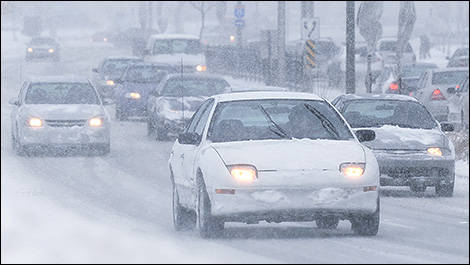Seeing clearly and being seen clearly by other motorists is key to proactive safety on the road in any season -- especially in wintertime.
When warm weather and daylight hours diminish in advance of the cold weather, visibility diminishes, too. Drivers spend more time travelling after the sun's gone down, as well as in rapidly changing weather conditions that can surround them with blowing snow, rain or fog.
During the winter, the high-visibility driving most motorists take for granted in the summer months can quickly disappear. Here are a few tips to maximize visibility on the go this winter to enhance safety for you, your passengers, and your fellow motorists.
Have your Lights Checked
If your headlight aim is out of whack, even a new set of bulbs won't help improve lighting quality. Check with your dealership or owner's manual for proper aiming procedures which can typically be carried out in a few minutes with a screwdriver. Note that headlight bulbs wear out and dim over time, so sometimes a simple bulb change is all that's needed to improve visibility.
Upgrade your Illumination
Some drivers may wish to consider upgrading their factory bulbs, which are typically selected for cost, not quality.
John Todorovic, Senior Application Engineer for SYLVANIA explains: "There is a relationship between lamp life, light output and colour temperature. In addition to meeting regulatory requirements, automakers are concerned with having lamps last the length of the car's warranty which may override their concerns to optimize both light output and colour temperature."
Looking for the ultimate in headlight performance for your ride? Consider a xenon HID retrofit kit from your favourite custom car shop. A quality HID kit for your ride will turn the dial up on illumination in a big way.
Winter Wipers
Many windsheild wipers have hinges and moving parts that can collect water, ice and snow in the winter months that cause them to freeze up and become ineffective. Solution? Winter wiper blades. These have a rubber or plastic cover to keep ice out of the hinges. Hinge-less, reflex-style blades are great in the winter, too.
Look for Premium Lighting
Shopping for a new ride? More automakers than ever offer premium lighting technologies in affordable models. If available, features like xenon HID headlamps, adaptive headlights, LED taillights and a headlight washer system all work to provide optimal visibility in bad weather. Some models from companies like Subaru, Hyundai and Toyota even have heated wipers, ensuring you won't suffer from a dangerous ice-up that impedes windshield-wiper performance all together.
Keep it Clear
Remember: In most provinces, driving a car covered in snow and ice can get you a ticket. It's common sense, but don't forget to clear snow and ice from your ride before you set off. Salt film should be cleared from your headlights and taillights whenever it starts impeding visibility, too.
Use the Good Washer Fluid
You've probably seen that yellow "De-Icer" washer fluid from RainX at your local retailer. It's a buck or two more than the cheap, blue stuff, but it's money well spent since it doesn't freeze and smear when it's cold outside (not even at 30 below).
At extreme temperatures that see cheaper washer fluids icing up on the windshield and blocking visibility, Rain-X only "freezes" for a fraction of a second. In a pinch, you can even mix it with the cheap stuff to improve its effectiveness and make the bottle of Rain-X last longer. Drivers benefit from a faster clearing action, built-in water repellency, and less ice buildup on the wipers.
Rachel Agnew, the Car Care Brand Manager at Shell Lubricants, explains what goes into Rain-X to make it different.
"Rain-X De-Icer windshield washer fluid is infused with water-repelling technology that seals the microscopic pores of glass with a super-slick, invisible barrier that repels rain, sleet and snow on contact. It resists freezing and streaking when it's very cold, thanks to the -40°C rated anti-freeze built into the formula".
Don't Forget the Housings
When it comes to illumination, headlight bulbs tend to get the most attention. However, even with high-performance bulbs and proper aiming, a damaged, cracked or faded headlight housing may impede proper light transmission. Have a close look at your headlights and check for condensation inside, as well as cracks or a frosted, faded look.
Headlights should be clear and clean, not covered in years of tiny rock chips and weather damage. If your bulb housings are yellowed or appear cloudy, you'll want to consider repairing or replacing them. An application of plastic polish, which you'll find near the car wax at your local retailer, may help. Retailers offer "headlight restoration" kits, too.
When warm weather and daylight hours diminish in advance of the cold weather, visibility diminishes, too. Drivers spend more time travelling after the sun's gone down, as well as in rapidly changing weather conditions that can surround them with blowing snow, rain or fog.
During the winter, the high-visibility driving most motorists take for granted in the summer months can quickly disappear. Here are a few tips to maximize visibility on the go this winter to enhance safety for you, your passengers, and your fellow motorists.
Have your Lights Checked
If your headlight aim is out of whack, even a new set of bulbs won't help improve lighting quality. Check with your dealership or owner's manual for proper aiming procedures which can typically be carried out in a few minutes with a screwdriver. Note that headlight bulbs wear out and dim over time, so sometimes a simple bulb change is all that's needed to improve visibility.
 |
| Photo: Matthieu Lambert |
Upgrade your Illumination
Some drivers may wish to consider upgrading their factory bulbs, which are typically selected for cost, not quality.
John Todorovic, Senior Application Engineer for SYLVANIA explains: "There is a relationship between lamp life, light output and colour temperature. In addition to meeting regulatory requirements, automakers are concerned with having lamps last the length of the car's warranty which may override their concerns to optimize both light output and colour temperature."
Looking for the ultimate in headlight performance for your ride? Consider a xenon HID retrofit kit from your favourite custom car shop. A quality HID kit for your ride will turn the dial up on illumination in a big way.
Winter Wipers
Many windsheild wipers have hinges and moving parts that can collect water, ice and snow in the winter months that cause them to freeze up and become ineffective. Solution? Winter wiper blades. These have a rubber or plastic cover to keep ice out of the hinges. Hinge-less, reflex-style blades are great in the winter, too.
Look for Premium Lighting
Shopping for a new ride? More automakers than ever offer premium lighting technologies in affordable models. If available, features like xenon HID headlamps, adaptive headlights, LED taillights and a headlight washer system all work to provide optimal visibility in bad weather. Some models from companies like Subaru, Hyundai and Toyota even have heated wipers, ensuring you won't suffer from a dangerous ice-up that impedes windshield-wiper performance all together.
Keep it Clear
Remember: In most provinces, driving a car covered in snow and ice can get you a ticket. It's common sense, but don't forget to clear snow and ice from your ride before you set off. Salt film should be cleared from your headlights and taillights whenever it starts impeding visibility, too.
Use the Good Washer Fluid
You've probably seen that yellow "De-Icer" washer fluid from RainX at your local retailer. It's a buck or two more than the cheap, blue stuff, but it's money well spent since it doesn't freeze and smear when it's cold outside (not even at 30 below).
At extreme temperatures that see cheaper washer fluids icing up on the windshield and blocking visibility, Rain-X only "freezes" for a fraction of a second. In a pinch, you can even mix it with the cheap stuff to improve its effectiveness and make the bottle of Rain-X last longer. Drivers benefit from a faster clearing action, built-in water repellency, and less ice buildup on the wipers.
Rachel Agnew, the Car Care Brand Manager at Shell Lubricants, explains what goes into Rain-X to make it different.
"Rain-X De-Icer windshield washer fluid is infused with water-repelling technology that seals the microscopic pores of glass with a super-slick, invisible barrier that repels rain, sleet and snow on contact. It resists freezing and streaking when it's very cold, thanks to the -40°C rated anti-freeze built into the formula".
Don't Forget the Housings
When it comes to illumination, headlight bulbs tend to get the most attention. However, even with high-performance bulbs and proper aiming, a damaged, cracked or faded headlight housing may impede proper light transmission. Have a close look at your headlights and check for condensation inside, as well as cracks or a frosted, faded look.
Headlights should be clear and clean, not covered in years of tiny rock chips and weather damage. If your bulb housings are yellowed or appear cloudy, you'll want to consider repairing or replacing them. An application of plastic polish, which you'll find near the car wax at your local retailer, may help. Retailers offer "headlight restoration" kits, too.





